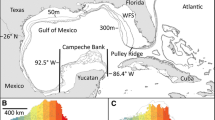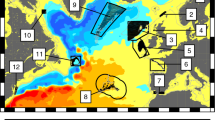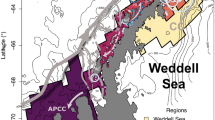Abstract
The lionfish invasion in the Atlantic and Caribbean has proceeded with vigor since their introduction in the 1980s or early 1990s. Lionfish affect recruitment of juvenile fish to reefs due to predation and are found in densities far surpassing that of their native Indo-Pacific. There is concern that the lionfish may become introduced and proliferate (through aquarium releases, transport on floating debris, or passage through the Panama Canal in ship ballast water) in the eastern tropical and north Pacific. This study presents the first known prediction of the potential for establishment of lionfish in the eastern Pacific Ocean. Through computational modeling, we compare and contrast the dynamics of random hypothetical introductions of lionfish into the eastern Pacific and Atlantic Oceans in order to highlight the different potentials for invasion in both basins. Connectivity between discrete regions (precincts) in both the Atlantic and eastern Pacific are examined and settlement densities are calculated to indicate possible locations of establishment of breeding lionfish populations. Our results suggest that lionfish, which are successful invaders in the Atlantic, may not be as successful in the eastern Pacific due to weak mesoscale connectivity which reduces the rapid spread of lionfish larvae.






Similar content being viewed by others
References
Ahrenholz DW, Morris JA (2010) Larval duration of the lionfish, Pterois volitans along the Bahamian Archipelago. Environ Biol Fishes 88(4):305–309
Albins MA, Hixon MA (2008) Invasive Indo-Pacific lionfish Pterois volitans reduce recruitment of Atlantic coral-reef fishes. Mar Ecol Prog Ser 367:233–238
Albins MA, Hixon MA (2011) Worst case scenario: potential long-term effects of invasive predatory lionfish (Pterois volitans) on Atlantic and Caribbean coral-reef communities. Environ Biol Fish. http://dx.doi.org/10.1007/s10641-011-9795-1
Albins MA, Lyons PJ (2012) Invasive red lionfish Pterois volitans blow directed jets of water at prey fish. Mar Ecol Prog Ser 448:1–5
Amante C, Eakins BW (2009) ETOPO1 1 arc-minute global relief model: procedures, data sources and analysis. In: NOAA technical memorandum NESDIS NGDC (24) p 19
Bagulayan A, Bartlett-Roa JN, Carter AL, Inman BG, Keen EM, Orenstein EC, Patin NV, Sato KNS, Sibert EC, Simonis AE, Van Cise AM, Franks PJS (2012) Journey to the center of the gyre: the fate of the Tohoku tsunami debris field. Oceanography 25(2):200–207. http://dx.doi.org/10.5670/oceanog.2012.55
Barbour AB, Montgomery ML, Adamson AA, Díaz-Ferguson E, Silliman BR (2010) Mangrove use by the invasive lionfish Pterois volitans. Mar Ecol Prog Ser 401:291–294
Chassignet EP, Hurlburt HE, Smedstad OM, Halliwell GR, Hogan PJ, Wallcraft et al (2007) The HYCOM (hybrid coordinate ocean model) data assimilative system. J Mar Syst 65(1):60–83
Claydon JAB, Calosso MC, Traiger SB (2012) Progression of invasive lionfish in sea grass, mangrove and reef habitats. Mar Ecol Prog Ser 448:119–129
Crooks JA, Soulé ME, Sandlund OT (1999) Lag times in population explosions of invasive species: causes and implications. Invasive Species Biodivers Manag 103–125
Freshwater DW, Hines A, Parham S, Wilbur A, Sabaoun M, Woodhead J, Akins L, Purdy B, Whitfield P, Paris C (2009) Mitochondrial control region sequence analyses indicate dispersal from the US East Coast as the source of the invasive Indo-Pacific lionfish Pterois volitans in the Bahamas. Mar Biol 156:1213–1221
Green SJ, Côté IM (2009) Record densities of Indo-Pacific lionfish on Bahamian coral reefs. Coral Reefs 28(1):107
Green SJ, Akins JL, Maljković A, Côté IM (2012) Invasive lionfish drive Atlantic coral reef fish declines. PLoS ONE 7(3):e32596
Hackerott S, Valdivia A, Green SJ, Côté IM, Cox CE, Akins L et al (2013) Native predators do not influence invasion success of Pacific lionfish on Caribbean reefs. PLoS ONE 8(7):e68259
Hamner, RM, Freshwater, DW, and Whitfield, PE (2007) Mitochondrial cytochrome b analysis reveals two invasive lionfish species with strong founder effects in the western Atlantic. J Fish Biol 71(sb):214–222
Hare JA, Whitfield PE (2003) An integrated assessment of the introduction of lionfish (Pterois volitans/miles complex) to the western Atlantic Ocean. In: NOAA technical memorandum NOS NCCOS (2) p 21
Houde E (1989) Comparative growth, mortality, and energetics of marine fish larvae: temperature and implied latitudinal effects. Fish Bull 87:471–495
Johnston MW, Purkis SJ (2011) Spatial analysis of the invasion of lionfish in the western Atlantic and Caribbean. Mar Pollut Bull 62(6):1218–1226
Johnston MW, Purkis SJ (2012) Invasionsoft: a web-enabled tool for invasive species colonization predictions. Aquat Invasions 7(3):405–417
Johnston MW, Purkis SJ (2013) Modeling the potential spread of the recently identified non-native panther grouper (Chromileptes altivelis) in the Atlantic using a cellular automata approach. PloS ONE 8(9)
Jud ZR, Layman CA (2012) Site fidelity and movement patterns of invasive lionfish, Pterois spp., in a Florida estuary. J Exp Mar Biol Ecol 414:69–74
Jud ZR, Layman CA, Lee JA, Arrington AD (2011) Recent invasion of a Florida (USA) estuarine system by lionfish Pterois volitans/P. miles. Aquat Biol 13(1):21–26
Kimball ME, Miller JM, Whitfield PE, Hare JA (2004) Thermal tolerance and potential distribution of invasive lionfish (Pterois volitans/miles complex) on the east coast of the United States. Mar Ecol Prog Ser 283:269–278
Kool JT, Paris CB, Andréfouët S, Cowen RK (2010) Complex migration and the development of genetic structure in subdivided populations: an example from Caribbean coral reef ecosystems. Ecography 32:1–10. doi:10.1111/j.1600-0587.2009.06012.x
Lorenzen K (1996) The relationship between body weight and natural mortality in juvenile and adult fish: a comparison of natural ecosystems and aquaculture. J Fish Biol 49(4):627–642
McGurk MD (1987) Natural mortality and spatial patchiness: reply to Gulland. Mar Ecol Prog Ser Oldendorf 39(2):201–206
Morris JA, Akins JL, Barse A, Cerino D, Freshwater DW, Green SJ, Munoz RC, Paris C, Whitfield PE (2009) Biology and ecology of the invasive lionfishes, Pterois miles and Pterois volitans. Proc Gulf Caribb Fish Inst 29:409–414
Morris JA, Shertzer KW, Rice JA (2011) A stage-based matrix population model of invasive lionfish with implications for control. Biol Invasions 13(1):7–12
Mumby PJ, Harborne AR, Brumbaugh DR (2011) Grouper as a natural biocontrol of invasive lionfish. PLoS ONE 6(6):e21510
Pappas S (2012) Live fish found in likely tsunami debris. http://www.livescience.com/28468-live-fish-tsunami-debris.html. Accessed 26 April 2013
Richards VP, Thomas JD, Stanhope MJ, Shivji MS (2006) Genetic connectivity in the Florida reef system: comparative phylogeography of commensal invertebrates with contrasting reproductive strategies. Mol Ecol 16(1):139–157
Ruttenberg BI, Schofield PJ, Akins LJ, Acosta A, Feeley MW, Blondeau J, Smith SG, Ault JS (2012) Rapid invasion of Indo-Pacific lionfishes (Pterois volitans and Pterois miles) in the Florida Keys, USA: evidence from multiple pre-and post-invasion data sets. Bull Mar Sci 88(4):1051–1059
Schofield PJ (2010) Update on geographic spread of invasive lionfishes (Pterois volitans [Linnaeus 1758] and P. miles [Bennett 1828]) in the Western North Atlantic Ocean, Caribbean Sea and Gulf of Mexico. Aquat Invasions 5(Supplement 1):S117–S122
Seebens H, Gastner MT, Blasius B (2013) The risk of marine bioinvasion caused by global shipping. Ecol Lett 16:782–790
Semmens BX, Buhle ER, Salomon AK, Pattengill-Semmens CV (2004) A hotspot of non-native marine fishes: evidence for the aquarium trade as an invasion pathway. Mar Ecol Prog Ser 266(1):239–244
USGS NAS (2013) United States Geological Survey-Nonindigenous Aquatic Species database (USGS-NAS). http://nas.er.usgs.gov. Accessed 29 Jan 2013
Whitfield PE, Gardner T, Vives SP, Gilligan MR, Coutenay Jr WR et al (2002) Biological invasion of the Indo-Pacific lionfish Pterois volitans along the Atlantic coast of North America. Mar Ecol Prog Ser 235:289–297. http://dx.doi.org/10.3354/meps235289
Whitfield PE, Hare JA, David AW, Harter SL, Munoz RC, Addison CM (2007) Abundance estimates of the Indo-Pacific lionfish Pterois volitans/miles complex in the Western North Atlantic. Biol Invasions 9(1):53–64
Williams SL, Crafton RE, Fontana RE, Grosholz ED, Pasari J, Zabin C (2012) Aquatic invasive species vector risk assessments: a vector analysis of the aquarium and aquascape
Wonham MJ, Carlton JT, Ruiz GM, Smith DL (2000) Fish and ships: relating dispersal frequency to success in biological invasions. Mar Biol 136(6):1111–1121
Acknowledgments
We thank the National Coral Reef Institute (NCRI) at Nova Southeastern University for support for this study. Thanks also to two anonymous reviewers for their valuable comments. This is NCRI contribution 158.
Author information
Authors and Affiliations
Corresponding author
Rights and permissions
About this article
Cite this article
Johnston, M.W., Purkis, S.J. Lionfish in the eastern Pacific: a cellular automaton approach to assessing invasion risk. Biol Invasions 16, 2681–2695 (2014). https://doi.org/10.1007/s10530-014-0696-z
Received:
Accepted:
Published:
Issue Date:
DOI: https://doi.org/10.1007/s10530-014-0696-z




